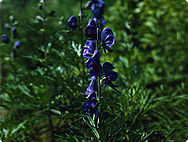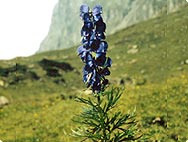A.Vogel search
When the internal search is activated, personal data such as your IP address is transmitted to our search engine Cludo. Data is thus transferred to a third country. Please click here if you want to display the internal search. You can find more information on data protection here: Privacy policy.
A.Vogel plant encyclopaedia
Aconitum napellus L.
Aconit
History

The name Aconitum is derived from the Greek akónitos, from akóne (= grindstone), composed of ak, meaning «pointed» or «sharp», and kônos, meaning «cone». The name probably refers to the pointed leaves. Ancient popular etymology connected the name in part to the adjective akonitós, which means «unvanquishable», in part to the name of the hill Akonitos in Pontus. This is the hill where Heracles brought the three-headed dog Cerberus from the Underworld and where, according to Ovid, the plant grew from the animal's slobber. The Latin species name napellus derives from nápus, which means «tuber», and refers to the form of the root.
Aconitum was well known in antiquity Medea is supposed to have murdered her son with it. It is also reported that Aristotle died of aconite poisoning. Dioscurides mentions that the root kills scorpions. Aconite was formerly used as a poison for arrows and to poison wolves hence the common name wolfsbane. Avicenna was the first to describe its use in nosebleeds, bleeding of the lung, dizziness, circulatory collapse, paralysis, consumption, and epilepsy. The Chinese have used a narcotic composed of arum, hyoscyamus, datura, and aconitum for centuries.
Botanical characteristics
Aconite is a stately plant up to 1.5 m high with a blackish, tuberous, fleshy root. The erect, strong stalk is covered with trifid to pentafid, deeply slitted, tapering, dark green leaves. The violet-blue flowers, whose uppermost involucre is helmet-shaped, are tightly clustered. The so-called helmet encloses two long-stemmed honey leaves (nectaries), also called doves of Venus' chariot. As fruits, three follicles develop with shiny black, three-edged seeds, winged on the margins. When the plant blooms, the tuber or nodule bearing the stalk develops a daughter tuber, which will provide the nutrition for the plant that grows from the bud in the following year.
Aconite flowers from June to August.
Habitat

Aconite can be found throughout Central Europe, from England to the Carpathians and from Portugal to Sweden, in mountainous locations at elevations up to 3000 m. It prefers rich, moist, and overfertilized soils, grazing pastures, and waste dumps.
Preparation
A.Vogel/Bioforce uses a homeopathic mother tincture produced in accordance with HAB 2003 from fresh, aboveground parts and root tubers collected when the plant begins to bloom. The potentisation of the dilution is carried out by shaking by hand.